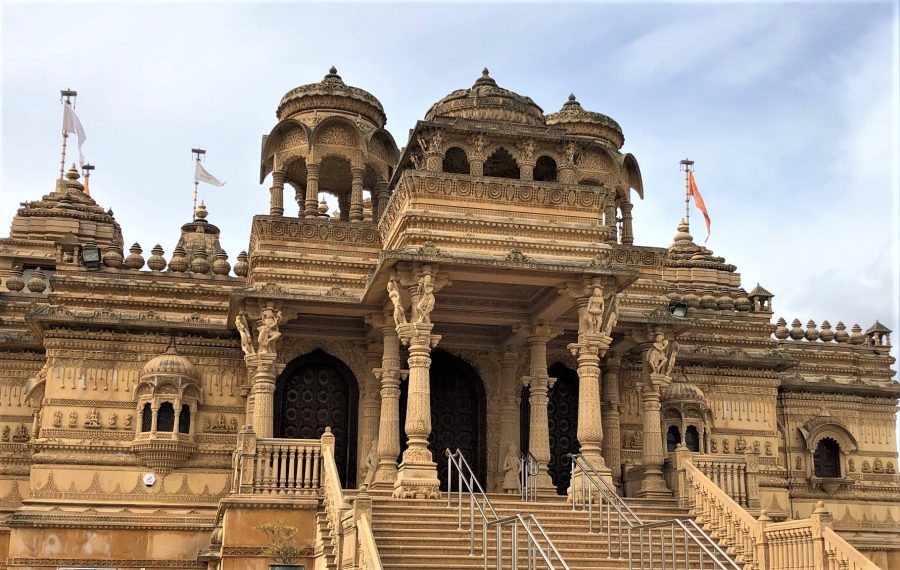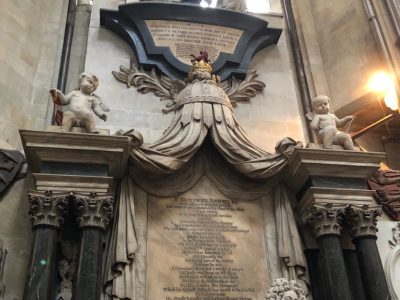
Take a trip to see India without leaving London
This beautiful Hindu temple is just 5 minutes walk from Alperton tube station.
This week I visited the Shri Sanatan Hindu Mandir near Wembley because a student group from America that I guide are planning to visit it later this year. It is quite a surprising building to find in suburban London. As you approach, bells hanging from the flag posts tinkle in a very atmospheric way.



Before my visit I contacted the temple to book and was sent some information about it and about the Hindu religion of which I must confess I am very ignorant as my generation was not taught anything about it at school.
So, I don’t take people on guided tours here and I am not guaranteeing that everything in this week’s blog is 100% accurate. I enjoyed trying to find out more about Hinduism and this is what I have understood from my research. Hopefully it is useful and will encourage visitors to the temple but I’d be happy to know more. So, if you can enlighten me please feel free to leave a comment.
About the building

Shri is used as an honorific title and means wealth or prosperity, Sanatanan means without beginning or end ie eternal and mandir means temple.
Wembley Shri Sanatan Mandir is very beautiful inside and out. It took 14 years to build and opened in 2010. Its design is based on traditional principals, with a square floorplan. The exterior is yellow sandstone from Jaisalmer and the interior is pink Bansi Paharpur stone. Both are in Rajasthan, India. The floor is marble. There are several domes with a central main dome that is 66 feet high.
The stone was intricately carved, mainly in Sola, Gujarat state, India and was brought to the UK to be assembled here. Inside the temple there are 210 pillars with carving and moulding that depicts Hindu scriptures. Between those images are hand carved leaves, flowers and feather shapes.
Every piece of wall and column inside is decorated in a harmonious way. The lighting inside is soft. The temple is quite busy with worshippers at all times of day. Some chanting together and others quietly walking round.
Visitors are asked not to take photos inside so I am only showing the exterior. The photo ban is to give worshippers privacy and to respect this place of worship.
From the entrance at the rear of the temple you take a one-way path clockwise around the inside.
Hinduism
The Hindu religion began perhaps around 4000 to 1500 BC but the earliest religious canons (called Vedas) were transmitted orally so it is difficult to date exactly. However, we know that Hinduism is the world’s oldest religion.
Hindus believe in one supreme being, Brahma, who created the universe. However there are many gods who are different aspects of the supreme being sent to help people on earth find the universal god that is within them.
In Hindu temples there are idols which are revered. This goes against the Judeo-Christian ideas that castigate the worship of idols so its a culture shock to hear them described as such. The idols in a Hindu temple are to help people connect with their gods. There are many different variations on the Hindu faith using different practices which makes it difficult to define. All the variations are accepted.
Handy Tip
Don’t visit between 12-1pm because curtains are drawn in front of the idols so if you want to see them go after 1pm.
The main idol in a Hindu temple is placed on a north south axis where a magnetic and electric energy lines is believed to be. The clockwise circuit around the main idol takes you past 40 other idols in this temple. Worshippers stop at the idols to pray and make offerings.
The circuit is called Pradakshina. Taking a circumscribed route symbolises losing your ego and it is believed that while making the circuit you are in contact with and will benefit from, the vibrations sent out from the temple’s central magnetic force.
The idols here are marble and were made in India. Some hold objects which are symbolic:

Image incorporating what looks like a number 3 – is the symbol for Om, a sound heard in deepest meditation
The conch shell – the sound it makes when blown is auspicious – it makes the Om sound
Trident (or Trishula) – is held by Shiva or the female goddess Dhurga. The three prongs symbolise different things including: creation, maintenance and destruction – past, present and future – clarity, knowledge and wisdom.
Damaru – like an hourglass shaped bongo drum, sometimes attached to Shiva’s trident symbolises the Om sound of creation.
Sudarshan Chakra – flat round disc with saw tooth edging is a weapon of Lord Vishnu to fight demons
Lotus Flower – symbolises purity, enlightenment, eternity, resurrection. Many idols are holding the flower and as you walk round you see at the first idol it is in bud. It gradually develops into a fully opened flower as you progress from one idol to the next.
Peacock feather – a symbol of Lord Krishna who wears one in his crown. It is also identified with Lakshmi and brings wealth and prosperity to the home. This feather is symbolic for many things, all good eg harmony, joy, protection.
Cobras – In battles between gods and demons a lethal poison that could destroy the universe was released. To stop this happening, the god Shiva drank the poison but his wife made sure he did not swallow it. Snakes that were nearby each took a little of it thus saving Shiva and the universe.
The snake sheds it skin which is considered symbolic of reincarnation. It also represents power, fertility and wealth.
Cows – Krishna was a cowherd and protects the cow. Cows conduct positive energy, they are usually gentle, do not eat meat, give milk which makes us healthy. Ghee made from butter is used for as the fuel for lamps and lamp-light symbolises knowledge.
Lord Shiva is often depicted tiding a white bull with a black tail, this is Nandi, symbolic of joy.
I hope you enjoy your visit to the temple.
For more ideas of things to see in London CONTACT ME






